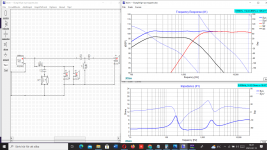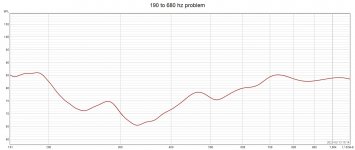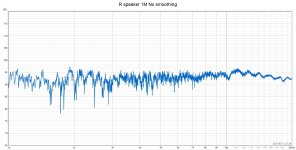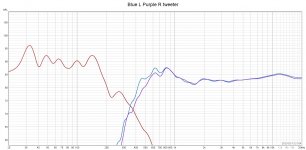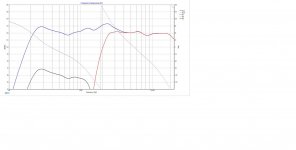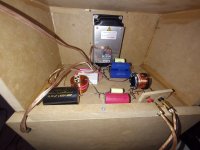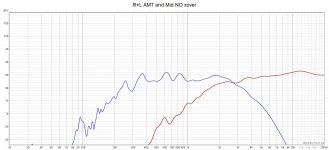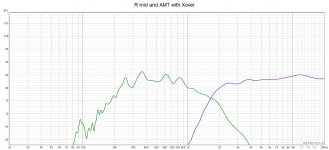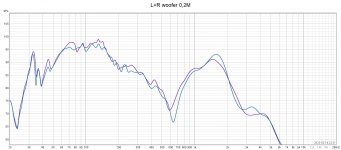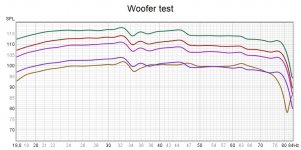Hello folks
Have build a DIY MTM with 2 x Audax HM210Z10 and a Mundorf AMT29CM1.1.
Woofer is 3 X Peerlees XXLS 12 inch per side vented in 102 liter netto, tuned at 22 hz
Xoverpoints are 340 and 1850 Hz, and i use a Active filter for both high and low feeding 2 stereoamps.
So woofers get all under 340 hz direct from active filter/amp, and midrange/top get everething over 340 hz from active filter/amp, but have a highpass filter.
Audax midrange have a 2 order filter and Mundorf AMT have a 3 order filter (from 1850 hz).
The measurements over 1K looks quite good, but i have a terrible deep long 19 dB dip from about 180-680 hz?
Don´t know where to start trubbleshooting?
Can´t do much under 340 hz sinse the active filter does "everything" for the woofers, and don´t understand why midrange curve is "so bad" from 340-680 hz, but same time is good from 1K ?
Anyone have some suggestions?
This is ihow it looks in XSIM, and yesterdays measurements.
Best regards John
Have build a DIY MTM with 2 x Audax HM210Z10 and a Mundorf AMT29CM1.1.
Woofer is 3 X Peerlees XXLS 12 inch per side vented in 102 liter netto, tuned at 22 hz
Xoverpoints are 340 and 1850 Hz, and i use a Active filter for both high and low feeding 2 stereoamps.
So woofers get all under 340 hz direct from active filter/amp, and midrange/top get everething over 340 hz from active filter/amp, but have a highpass filter.
Audax midrange have a 2 order filter and Mundorf AMT have a 3 order filter (from 1850 hz).
The measurements over 1K looks quite good, but i have a terrible deep long 19 dB dip from about 180-680 hz?
Don´t know where to start trubbleshooting?
Can´t do much under 340 hz sinse the active filter does "everything" for the woofers, and don´t understand why midrange curve is "so bad" from 340-680 hz, but same time is good from 1K ?
Anyone have some suggestions?
This is ihow it looks in XSIM, and yesterdays measurements.
Best regards John
Attachments
It is hard to measure inside a room due to the close surfaces. According your gating (5 to 7 ms ?), the best you can do for minimal accuracy is measurement above 500/600 hz if the cabinet is at the mid space between the floor and ceilling in usuals room heigths. For more precisiob you need to measure outside at bigger heigth or on the floor level for bass.
Maybe a part of your dips below that is about that there are always dips due to the room, I thing at least the 180 hz is the room as usual...
Maybe a part of your dips below that is about that there are always dips due to the room, I thing at least the 180 hz is the room as usual...
Hi, 19db seems deep, like mids were not participating at all. Check if they are wired correctly, and in same polarity with each other.
Another, assuming measured response is in room response without short gating the response would look more like power response of the speaker and not like on-axis response, especially on the midrange. Pair of mids would have dip in power response, when axial response is equalized flat with a tweeter. Also bafflestep would show up in the measured response and make difference to simulation, if the driver responses in simulation are datasheet responses not including effects of baffle. These wouldn't make 19db difference though so my bet is on wiring error.
Another, assuming measured response is in room response without short gating the response would look more like power response of the speaker and not like on-axis response, especially on the midrange. Pair of mids would have dip in power response, when axial response is equalized flat with a tweeter. Also bafflestep would show up in the measured response and make difference to simulation, if the driver responses in simulation are datasheet responses not including effects of baffle. These wouldn't make 19db difference though so my bet is on wiring error.
It is hard to measure inside a room due to the close surfaces. According your gating (5 to 7 ms ?), the best you can do for minimal accuracy is measurement above 500/600 hz if the cabinet is at the mid space between the floor and ceilling in usuals room heigths. For more precisiob you need to measure outside at bigger heigth or on the floor level for bass.
Maybe a part of your dips below that is about that there are always dips due to the room, I thing at least the 180 hz is the room as usual.
Totaly agree that measurement is hard and damn frustrating, especially below 3-400 hz.
I don't understand what you mean with "According your gating (5 to 7 ms ?)", and are NOT good at REW program and its settings.
The mid/top is about "between the floor and ceilling", and the room is 5 meter wide and 10 meters long, ceiling height approx. 2.5 meters.
Speaker is in 4 colums each, 215 kilo per side...SSo can´t take them outside.
Also broken back unfortunately.
Hi, 19db seems deep, like mids were not participating at all. Check if they are wired correctly, and in same polarity with each other.
Another, assuming measured response is in room response without short gating the response would look more like power response of the speaker and not like on-axis response, especially on the midrange. Pair of mids would have dip in power response, when axial response is equalized flat with a tweeter. Also bafflestep would show up in the measured response and make difference to simulation, if the driver responses in simulation are datasheet responses not including effects of baffle. These wouldn't make 19db difference though so my bet is on wiring error.
Agree, 19 dB is so much!
Will check wiring in the mid/twe filter, but im often so exact when i do things so I would be very surprised if that were the case.
Did som measurement with only the mid/topp (woofer-amp off), and some on only woofer (with mid/twe amp off).
Separate mesaurements on Left and Right MTM from 1 meter.
Blue is Left tweeter and Purple is Right
Attachments
The dip bottoms out at 340Hz which is your xo frequency ? Have you tried swapping polarity of the bass drivers ?
Was my first thought also, but not sure how as I have 3 XXLS 16 ohm woofers paralleled per side by active filter.
The active filter is DBX 234 Xs, and i have test to push the "Invert" button for the woofers on both left and then right side.
Mesaurement shows no differance when using DBX "iNVERT" button.
And this is the first time i use active and passive xover together.
But strange if the passive filter can impact the active xover-point ?
Or am I thinking wrong?
I'm thinking something wrong on your dbx settings. Your runs with woofer only and mtm only show dips deeper than i'd expect. Maybe drive the mtm without the dbx to see what the response is.
how measure the Audax alone with your setup ? They seem not be here on the measurement ?
The measurement obove is left and right MTM through active filter DBX 234 Xs, ( and the built-in passive filter)
Difficult to access the MTM xover, but will try tomorrow.
And only measure the Audax alone without DBX and passive filter.
I'm thinking something wrong on your dbx settings. Your runs with woofer only and mtm only show dips deeper than i'd expect. Maybe drive the mtm without the dbx to see what the response is.
Yes the DBX don´t make me feel "good", the first one i orderd was sent back because of 8 dB differance on right and left channel.
And this "new" one have also differences in left and right output, so i have to screw down the left side about 5 dB.
And I think DBX gives me uncertainty in all the data, so you wonder if it is the one that is set up incorrectly or is causing problems
Can you post a pic of bass mid tweeter sweeps without any crossover in place, on 1 graph in REW,
Then post a pic of bass mid tweeter sweeps with crossovers in place on 1 graph in REW.
May help people work out what's going on.
Is it okey to take 2 x midrange and AMT and woofer without xover ( thinking of ohm)
Or should i only use 1 midrange and AMT together with MTM amp, and 3 x woofer alone with woofer-amp?
And how measure woofer?
in the middle of them....Close or 1 m ?
The 'normal' process is to have raw measurements of each 'way' in the speaker before designing the crossover. So a sweep of the tweeter, a sweep of the mids (both mids in the mtm) and a sweep of the bass, with no crossover in place.
Usually you would take these measurements outside to try and lose any room influence.
You would also take an impedance sweep of each 'way' to complete the zma and frd files to load into xo design software. If you want to really go for it you would do off axis measurements as well, horizontal and vertical.
In your case where you can't move the speakers due to weight I would measure at 1 metre in line with tweeter and use those measurements as a bassline.
Personally I would be looking at using the closest bass driver to the mids up to the 340Hz xo, with the other 2 running as 0.5 way drivers as well.
Rob.
Usually you would take these measurements outside to try and lose any room influence.
You would also take an impedance sweep of each 'way' to complete the zma and frd files to load into xo design software. If you want to really go for it you would do off axis measurements as well, horizontal and vertical.
In your case where you can't move the speakers due to weight I would measure at 1 metre in line with tweeter and use those measurements as a bassline.
Personally I would be looking at using the closest bass driver to the mids up to the 340Hz xo, with the other 2 running as 0.5 way drivers as well.
Rob.
You would also take an impedance sweep of each 'way' to complete the zma and frd files to load into xo design software.
Thanks for helping
How you take impedance measurements in REW ?
Never did that before.
Can you post a pic of bass mid tweeter sweeps without any crossover in place, on 1 graph in REW,
Then post a pic of bass mid tweeter sweeps with crossovers in place on 1 graph in REW.
I will soon go down in the basement and make some measurements, and i have look at some "old" data from the MTM build.
And when i look at the passive xover and use the values with XSIM, and look at the 1 dB curve, the dip is about the right in some way.
Only that XSIM shows 1,1 dB down at 550 hz and mesaurement shows 19 dB dip att about 340 hz.
But there are similarities even if they are to different degrees.
And have read about REW and impedance, and i dont have "things" needed at home, so today only driver mesaurement without xover.
Best regards John
Attachments
Hard work, the xover is like glued in the middle of the MTM box and my arms is short 😉
No DBX involved, only my Yamaha CX-A5200 homecinema-preamp straight
Did separate mesaurement on Left side both with and without xover, on midrange and AMT tweeter.
My passive xover diden´t change much, exept at the beginning on the tweeter and at the end of the midrange.
Lower the mids on mesaurement, so leveled with tweeter!
Be back with more soon!
Regards John
No DBX involved, only my Yamaha CX-A5200 homecinema-preamp straight
Did separate mesaurement on Left side both with and without xover, on midrange and AMT tweeter.
My passive xover diden´t change much, exept at the beginning on the tweeter and at the end of the midrange.
Lower the mids on mesaurement, so leveled with tweeter!
Be back with more soon!
Regards John
Attachments
- Home
- Loudspeakers
- Multi-Way
- Big dip between active and passive filter around crossingpoint?
